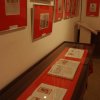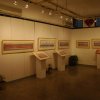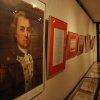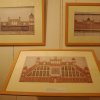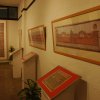Curated by Jean-Marie Lafont and Dhir Sarangi
Following the death of Aurangzeb in 1707, the collapse of the Mughal Empire led to the emergence of “successor states” in India. These principalities of Avadh, Rohilkand, Hyderabad, and Mysore, which engendered new socio-political identities, were now compelled to modernize their administrative and military infrastructures in order to survive the growing influence and territorial expansion of the East-India Company. Indian statesmen began to introduce military reforms with the help of European specialists, resulting in a ‘cultural encounter’ in the late 18th century.
Jean-Baptiste Gentil, a French military officer who first arrived in India in 1752, served Kasim Ali Khan, Nawab of Bengal, and then, Shija-ud-daula, the Nawab of Avadh. Drawn to pre-Mughal, Mughal and contemporary architecture, he commissioned a series of large paintings of palaces in Delhi, Agra and Faizabad in 1772-1774. The core of the exhibition, amassed from Gentil’s collection, included 15 reproductions of these paintings from the Bibliothèque Nationale, Paris and 5 more documents from the Victoria & Albert Museum, London. They display the Chandni Chowk, the Faiz bazaar, the Red Fort and a garden of the Mughal emperor in Delhi.
An intense cultural life developed in Avadh from the 1770s till the 1820s after the brutal sacking of Delhi by Nadir Shah and Ahmed Shah Abdali. As a result, several rare manuscripts reached the Nawabs, some of which were purchased by Europeans. The exhibition also featured, for the first time, illustrations of miniature paintings and unpublished manuscripts from the Gentil Collection.
The exhibition thus illustrated beautiful Mughal monuments of Delhi (and even a pre-Mughal one – the “Blue palace” of Salim Shah Suri), most of which had disappeared in 1844. It also demonstrated the trends of the Avadh School of paintings later illustrated in the Polier and Claude Martin collections and which developed into the “Company painting” style. In this way, this display of the lost palaces of Delhi focussed on a direct association with the means of cultural reciprocity shared between Europe and India, with particular emphasis on Avadh.
This exhibition was possible with the support of the ECCP programme of the Delegation of the European Commission to India, in partnership with EURINDIA along with the special permission of Bibliotheque Nationale de France (BnF), Paris and Victoria and Albert Museum, London.


